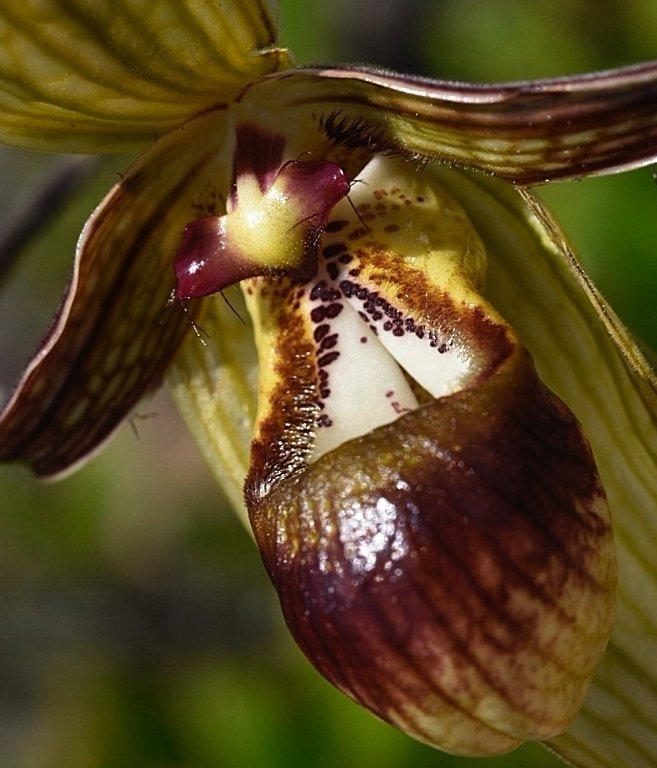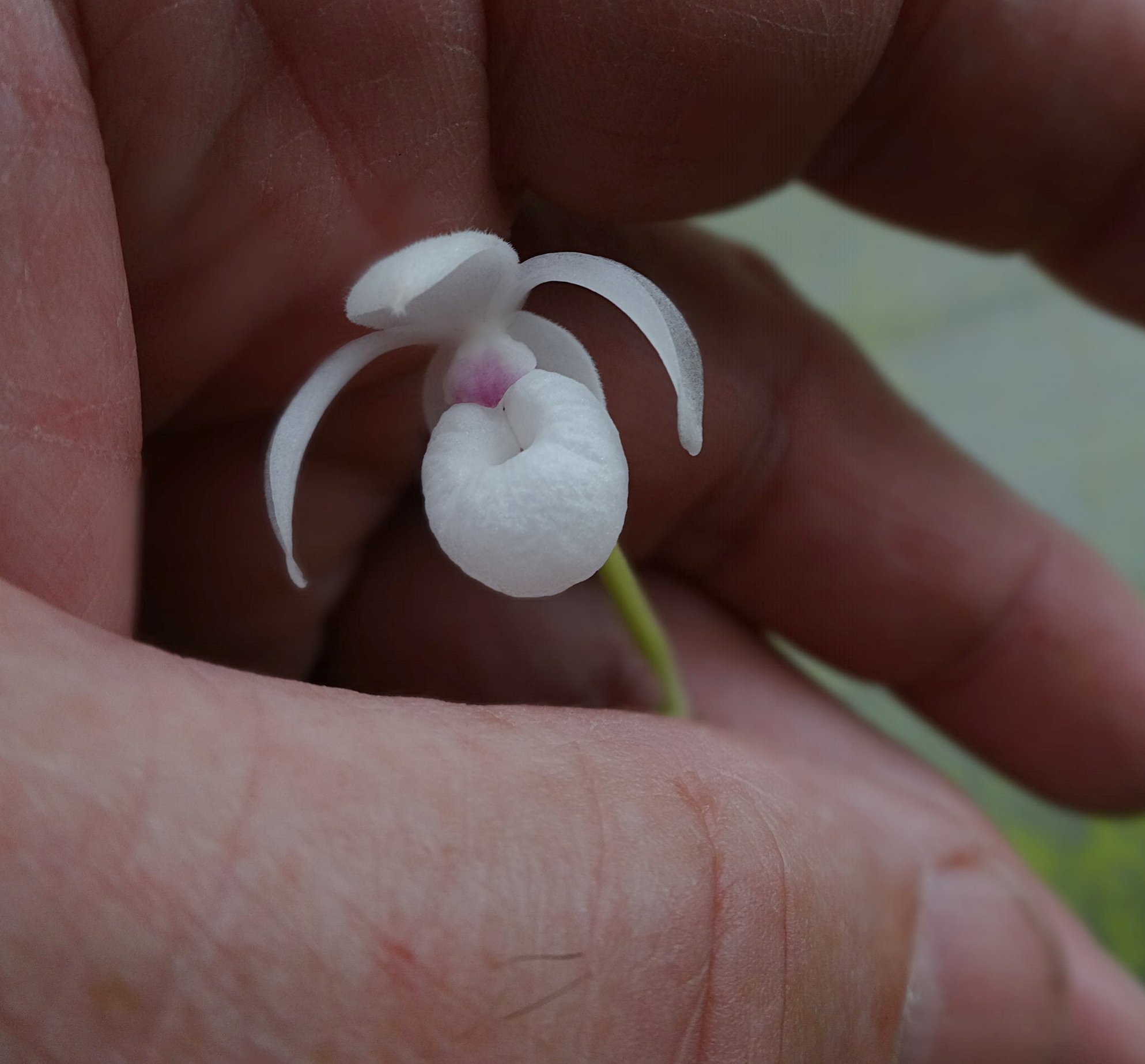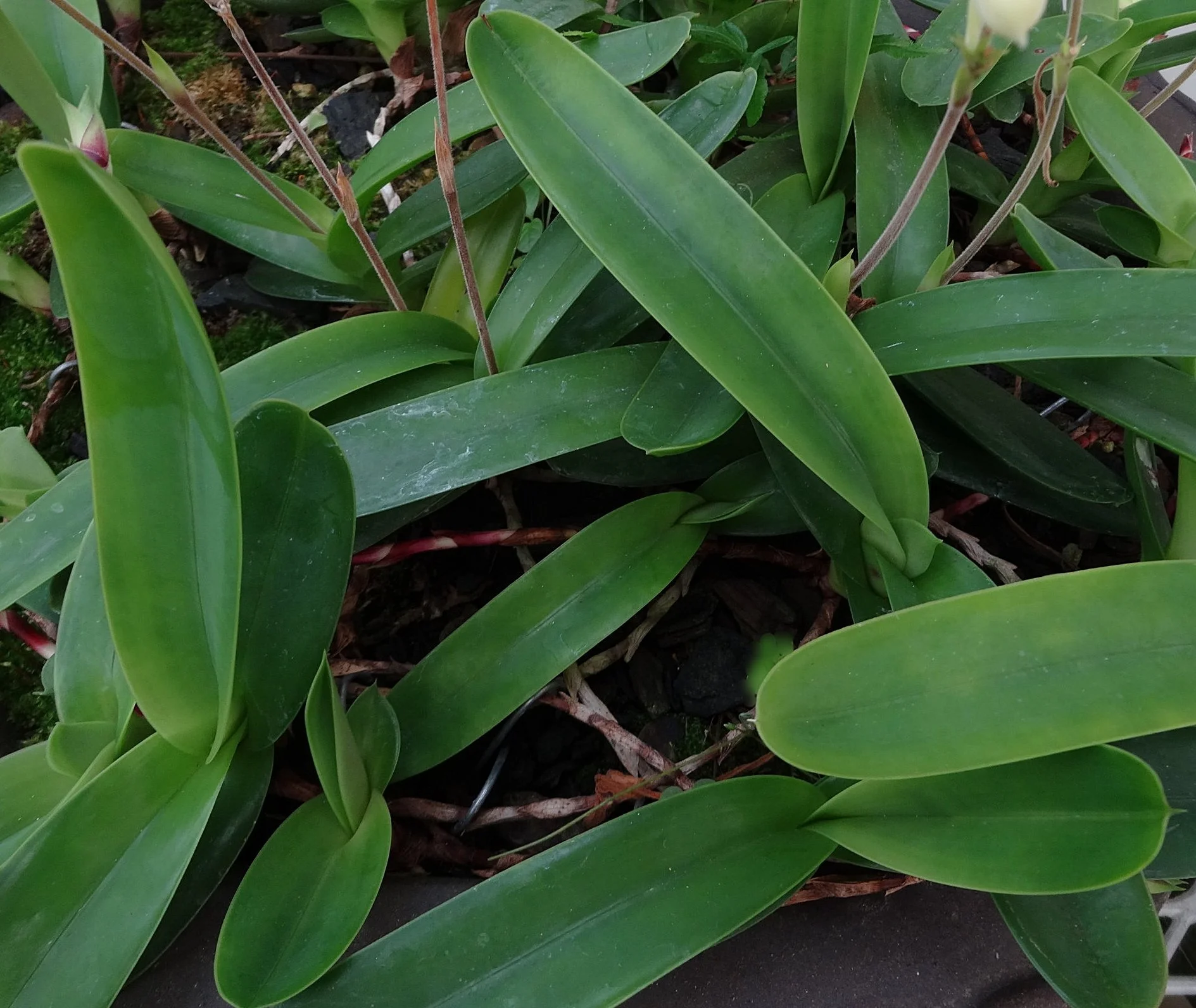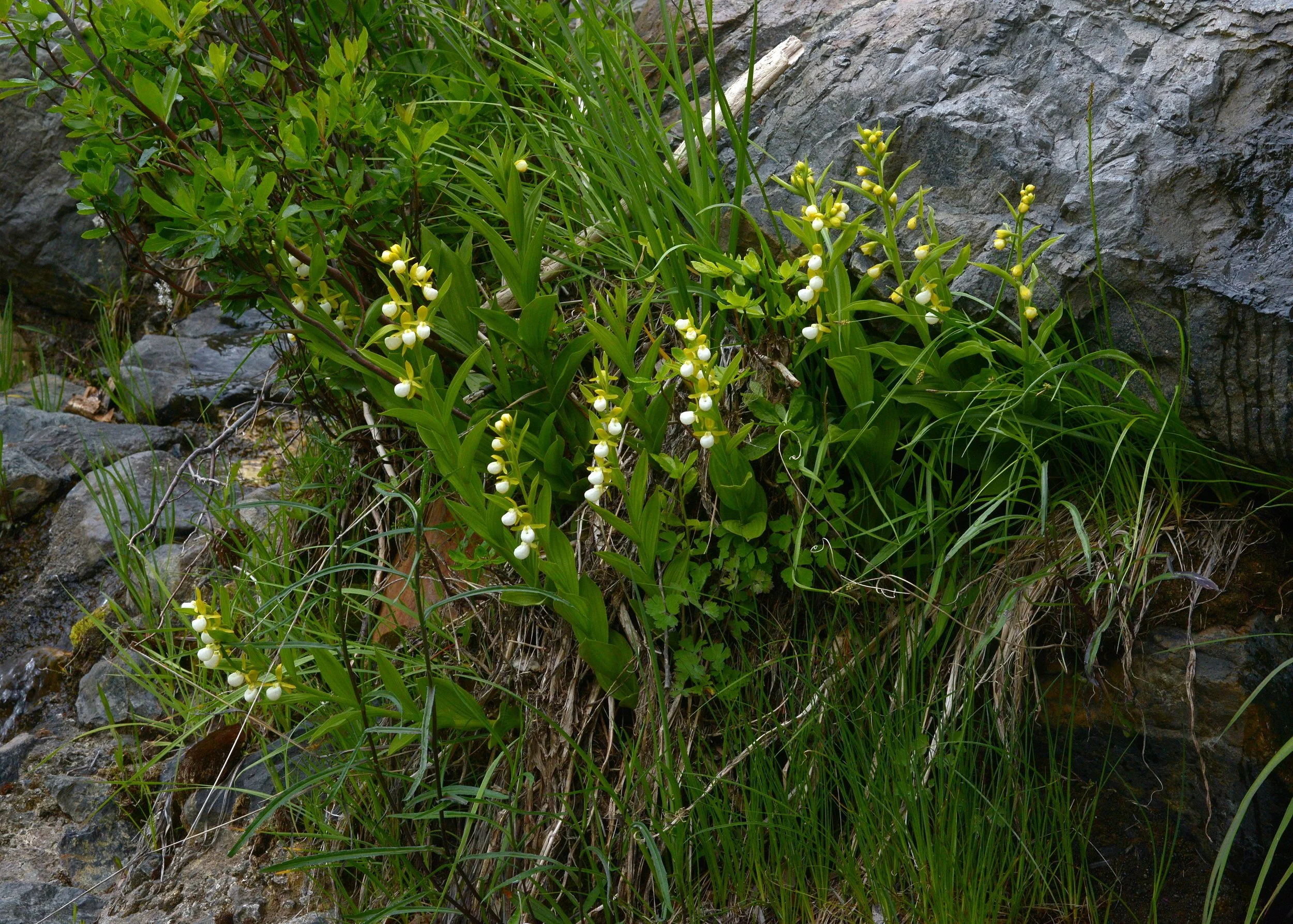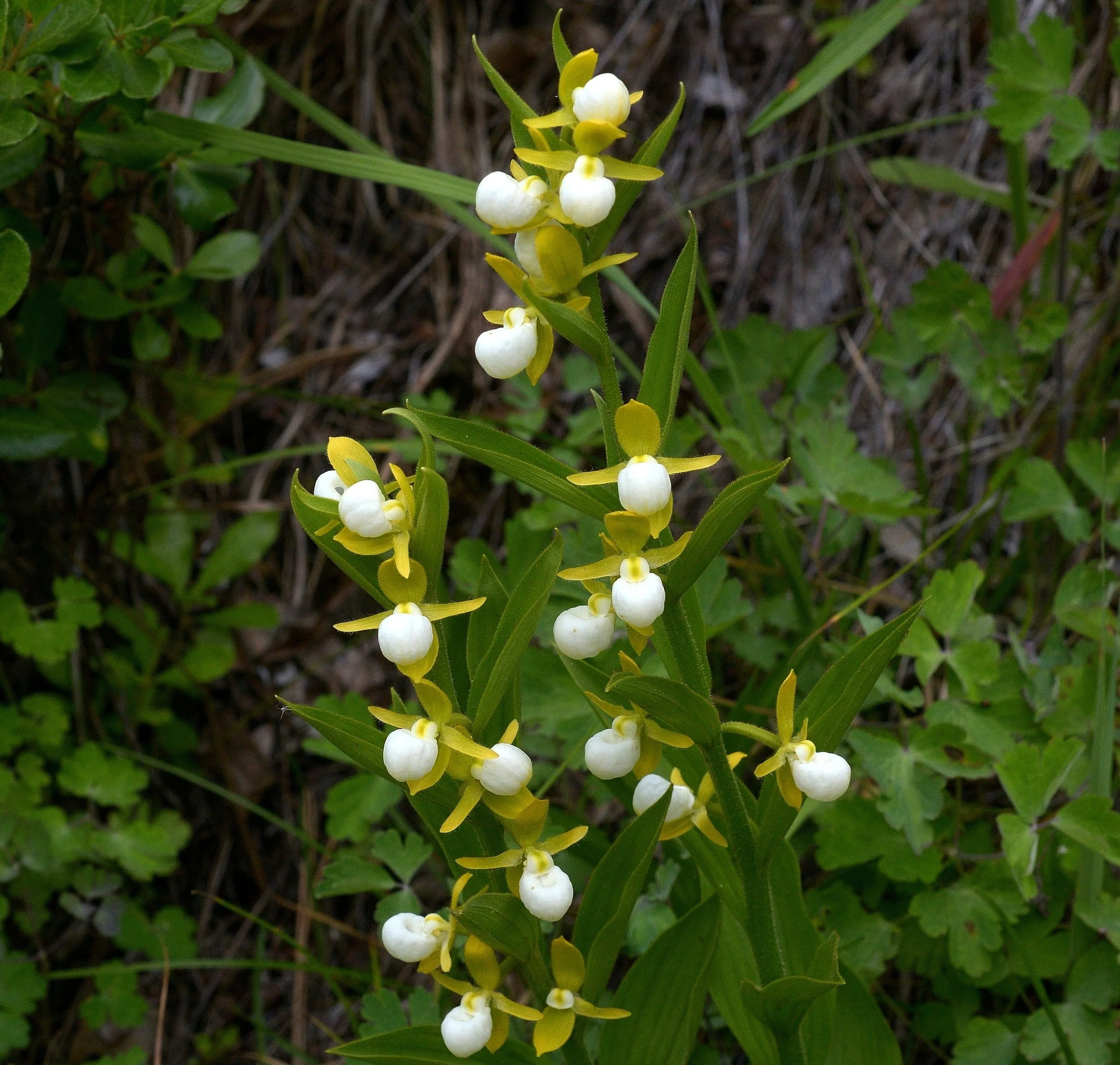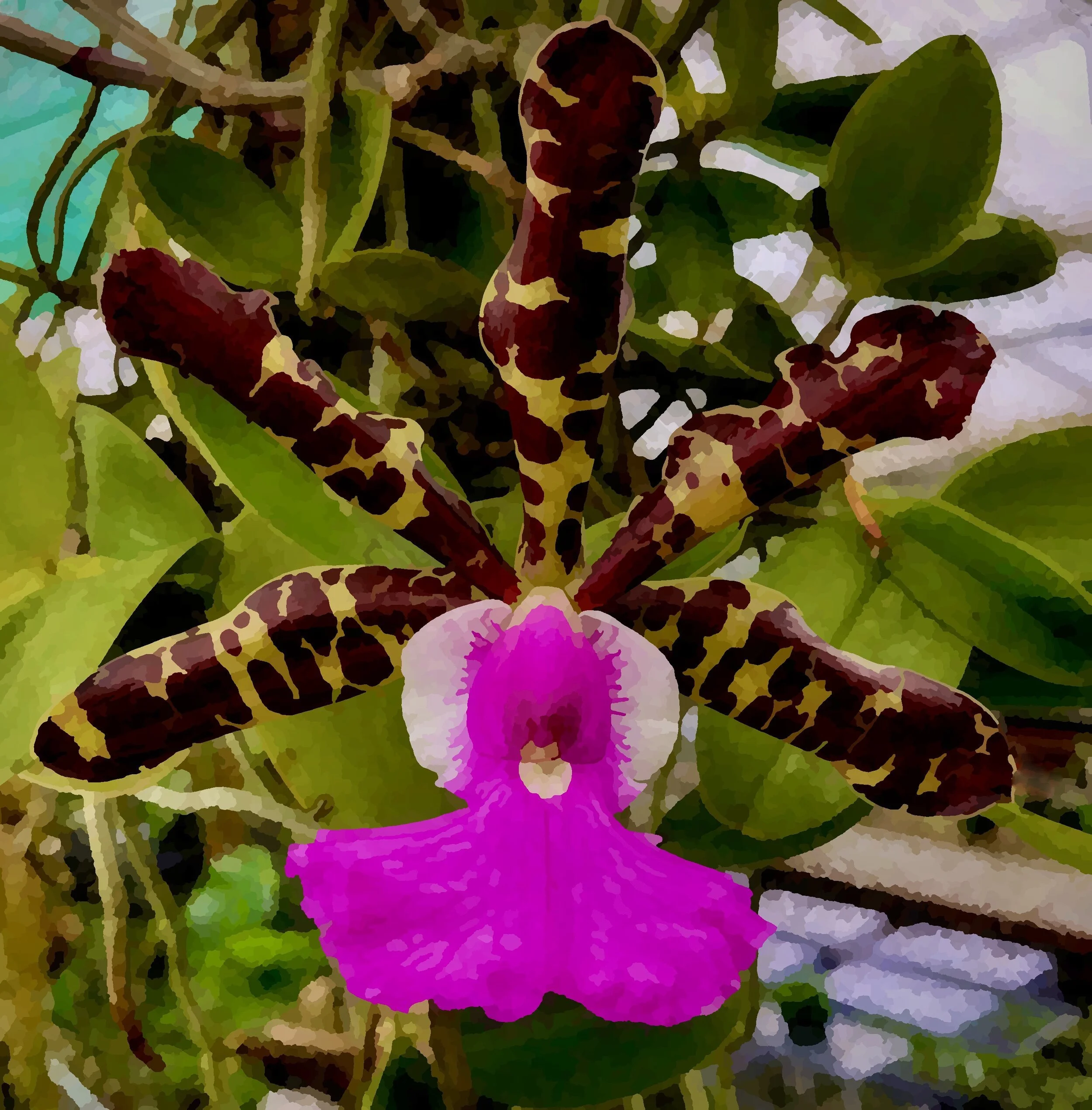The Secret Lives of Mesoamerican Slipper Orchids
by Jay Vannini
Flowers of the endangered natural hybrid slipper orchid Cypripedium x fred-mulleri in nature, Alta Verapaz, Guatemala. This particular flower has a divided synsepal. Image: ©F. Muller.
Slipper orchids (Subfamily Cypripedioideae) are a very popular group of ornamental plants in cultivation. The search for novelties and rare slipper orchid species has launched many ships since the 1800s. There are five genera currently recognized, three of which are widespread in global ornamental horticulture. In steep descending order of popularity and economic importance these are Paphiopedilum, Phragmipedium and Cypripedium. Of the remaining two genera, one (Mexipedium) is a critically endangered, monotypic collectors’ specialty and the other (Selenipedium – eight species) has a few extralimital species that are just now starting to find a very small niche following in a few botanical gardens and advanced private collectors with enough head space to grow them to their often-imposing flowering size.
More than any other orchid group, slipper orchids can inspire a degree of devotion in their admirers that is noteworthy–or perhaps a bit alarming?–to even the most hardcore “normal” orchid collectors. They have spawned both a humorous noun and nursery of the same name (Paphanatics) as well as any number of risqué references about their lips’/slippers’ appearance. Several slipper orchid genera have been granted special anti-trafficking protections under the multilateral Convention on International Trade in Endangered Species (CITES). Since the inclusion of all Paphiopedilum, Phragmipedium and Mexipedium species on CITES Appendix I in 1989, undocumented or improperly documented imports of these plants have sparked a number of federal investigations in both the EU and the U.S., prompted armed police raids on several private collections and nurseries, derailed and wrecked professional careers, ruined reputations and friendships, resulted in hefty fines and prison time, and inspired two books written about them and their keepers; Eric Hansen’s “Orchid Fever” (2001) and Craig Pittman’s “The Scent of Scandal” (2012).
The author photographing flowering Cypripedium dickinsonianum in mixed oak-agave habitat, central Guatemala. Image: ©J. Vannini
Mesoamerica is home to three of the five slipper orchid genera and at least six accepted species, one of which, Mexipedium xerophyticum, is a regional endemic from the Chimalapas region of eastern Oaxaca while two, Phragmipedium humboldtii and P. longifolium, are wide-ranging species with a pair of subspecies recognized (or not) for each by some orchid taxonomists and hobbyists. The very rare central Panamanian Selenipedium chica occurs outside of Mesoamerica proper. The remaining three (or five, or seven, depending on who you believe) species of tropical yellow-flowered New World lady’s slipper orchids (Cypripedium species) are some of the most showy-flowered and poorly-understood terrestrial orchids occurring in the hemisphere. Their glamour and desirability among some orchid collectors stem partly from the facts that, stunning looks and threatened status aside, thus far, they have proven impossible to cultivate long-term outside of their countries of origin (México, Guatemala and Honduras). Two of them have rarely been seen alive since their discovery by any other than local residents or a couple dozen botanists and naturalists.
Since there is continuing interest in the ecology, taxonomy and distribution of regional slippers, I’ve updated some earlier notes that I had posted on the internet during the last decade and a half that dealt with the yellow-flowered Neotropical cypripediums. I have also added information on both Mexipedium xerophyticum and the two regional Phragmipedium species gleaned from my own experience with these species in the wild (both phragmipediums only) and in cultivation (all three species), as well as information provided by two friends in the region who have also worked extensively with Mesoamerican slipper orchids in the field.
Phragmipedium
Looking like an enchanted creature from a fairy-tale, a very striking flowering Phragmipedium humboldtii with >30”/75 cm petals growing as an epiphyte on a mossed buttress in cloud forest, Baja Verapaz Department, Guatemala. Other unflowered plants are visible on lower left edge Image: ©F. Muller.
Phragmipedium humboldtii has very striking and dramatic flowers by any standards. It is part of a small complex of slipper orchid species ranging from cloud forests of southeastern México to Perú that are characterized by their long petals that can, in some exceptional examples from northern Mesoamerica, exceed 3’/1.0 m in length. The species proper is known from cloud forests of extreme eastern Chiapas, México discontinuously to western Panamá. They are very popular with both regional and foreign orchid collectors and are not difficult to cultivate but can be prone to both fungal and bacterial blights if kept poorly-ventilated or too wet. They can be successfully maintained in any free-draining medium in smaller pots, plant baskets and - if heavily-watered - on mossed cork mounts. Like many phragmipediums, this species tends to perform best in cultivation when pure water is used to grow them. They may be found in nature in lower montane and montane wet and rainforests between about 4,200’/1,300 m and 8,100’/2,500 m growing as epiphytes, lithophytes, terrestrials and occasionally on decomposed fallen trees. It has long been known by growers that to achieve maximum petal length and perfect flower form, the petal tips must not come in contact with anything solid during the elongation process or their growth with be truncated.
A well-flowered cultivated Colombian Phragmipedium warscewiczianum, formerly P. wallisii in horticulture (Grower and image: ©P. Rockstroh.
The tangled taxonomy of northern Central American and Mexican phragmipediums is a source of frustration to many slipper orchid growers. Despite the enormous amount of time and effort spent on trying to resolve this issue, there is still a good deal of debate among orchid specialists as to what name/s should be applied to plants from the northern part of their range. Phragmipedium humboldtii has been known under a wide variety of binomials in recent years, including: exstaminodium, warscewiczii, warscewiczianum (true species shown left), caudatum, popowii, triandrum and monstruosum. Some of these taxa have alternated over the years between specific and subspecific status. Franco Pupulin of the Universidad de Costa Rica’s Lankester Botanical Gardens has recently taken yet another stab at sorting out the chaos surrounding the right name for these plants.
For those interested in the “inside baseball” of this discussion, I refer you to his excellent summary, arguments and conclusions. Please note that clicking on link below will take you offsite. Use your back button to return to this article:
First flowering on a young, seed-origin Phragmipedium humboldtii grown mounted on a cork plaque in California. Petals >32”/81 cm in length. Overall flower length in exceptional forms of this species in Guatemala can exceed 39”/100 cm, with three flowers per inflorescence. Author’s plant and image.
Noteworthy contemporary orchid researchers who have also tackled the naming of these taxa include John Atwood, Eric Cristenson, Robert Dressler, Guido Braem, Eric Hagstater, Phillip Cribb and Miguel Soto Arenas. Regional orchid workers Eduardo Pérez-García and Edgar Alfredo Mó published a very complete and well-illustrated general summary on the status of slipper orchids in Mexico and Central America in 2013 and proposed several taxonomic revisions and combinations for Guatemalan populations of Phragmipedium. The fact that there is still disagreement among many of these very well-respected botanists is indicative of how thorny the naming problem remains.
Phragmipedium humboldtii growing as an exposed lithophyte in lower montane forest, Chiriquí Province, Panamá. Image: ©F. Muller.
Without delving too deeply into this debate, I favor the view that Phragmipedium humboldtii is a classic ochlospecies as defined by Cronk (1998). Specifically, “An ochlospecies is a polymorphic species with chaotic infraspecific variation which is intractable to formal taxonomic treatment…”
So far, so good!
A peloric/pouchless Phragmipedium humboldtii from central Guatemala. Image: ©E. Ramos Bamaca, courtesy of E. A. Mó.
When this species was still relatively common in nature and in the live plant trade in Guatemala during the 1970s and 1980s, it was frequent to see hundreds of wild-collected Phragmpiedium humboldtii for sale at roadside vendors located near small villages of central Guatemala. Random sampling of these plants yielded extremely robust (polyploid?) plants with very large and long flowers, as well as less impressive forms, all collected in the same region. Although I had not seen a plant or an image of one until very recently, peloric examples of this species that lack a pouch have now been encountered in nature, rounding out the extreme variability that may be found among plants in any given population in Guatemala. The subspecies (or form?) exstaminodium from eastern Chiapas and western and central Guatemala is diagnosed by its (obvious) lack of a staminode and autogamous self-pollination. While it appears to be a fairly stable trait in Chiapan plants, this character appears to be erratically embedded in some Guatemalan populations where they may occur in near sympatry with the nominate subspecies - identified here by the presence of an arrowhead-shaped staminode in their flowers. Likewise, examples resembling a published image of the extremely robust-flowered form collected at higher elevations of Alta Verapaz and self-published as P. “monstruosum” in 1999 by a Guatemalan amateur botanist, have also been seen mixed in with trade plants originating from and sold near La Unión Barrios in Baja Verapaz Department by me. Further east and south into Honduras the debate over the validity of ssp. (or species) exstaminodium becomes irrelevant. It may be worth noting that Koopowitz (2008) suggested that the absence of a staminode was a recessive trait in this taxon since while plants from selfings lacked one, progeny from all outcrosses he made with it all possessed staminodes. An examination of the photos shown below of wild P. humboldtii in north-central Guatemala and western Panamanian cloud forests shows how uniform the key floral characters can be across almost their entire range. I favor the notion that this species is locally variable, with “very dark”, “long-petaled”, “giant-flowered”, autogamous, aberrant and peloric flowered plants occurring in nature that are of interest to orchid collectors but warrant neither specific nor subspecific status and are best considered local forms.
Flower detail of the “exstaminodium” form of Phragmipedium humboldtii growing in cultivation. The conspicuous lack of a staminode, leaving the pollinia exposed, gives this plant its name. This autogamous plant form occurs in several relict plant populations from eastern Chiapas, México to central Guatemala. While still recognized by some authorities as a valid species, P. exstaminodium Castaño, Hágsater & E. Aguirre, the apparently random presence of individuals lacking staminodes growing alongside plants with normal-looking flowers suggests a reevaluation of this taxon (or its key diagnostics) is necessary. Grower: T. Perlite, Golden Gate Orchids. Image: ©J. Vannini.
Flower detail of a line-bred Phragmipedium humboldtii (misnamed P. “popowii” by the breeder) in the author’s California collection. Author’s image.
Details of wild-growing Phragmipedium humboldtii from Baja Verapaz Department, Guatemala (above left) and Chiriquí Province, Panamá (above right) showing the similarity of key characters of lip morphology of plants from the northern and southeastern extremes of its geographical range. Images: ©F. Muller. See photo shown right for an example of a cultivated plant in the U.S. bred from plants of unknown wild provenance that shows diagnostic floral characters matching images shown above. Image: ©J. Vannini.
Flowering Phragmipedium humboldtii in cloud forest, western Panamá. Image: ©F. Muller.
Phragmipedium longifolium inflorescence in nature, Chiriquí Province, Panamá. Image: ©F. Muller.
Phragmipedium longifolium has even more synonymized subordinate taxa named than the previous species (10), but fortunately more consensus exists about the validity of its current binomial. A recent paper by Braem (2015) plausibly proposes that all of the named subspecies and varieties of P. longifolium across its extensive geographical range (northwestern Costa Rica to northern Brazil and Perú) are, in fact, also just local variants that do not warrant formal status. This species has a surprising tolerance of a variety of environmental conditions, from lowland Tropical Rain Forest near sea level to Lower Montane Rain Forest at over 5,200’/1,600 m, so adaptation to local microclimates is probably driving intraspecific variability. In ornamental horticulture, several of these populations are still marketed as “good” varieties, especially “hincksianum” and “gracile”. At single localities in western Panama I have visited there is a conspicuous amount of variation among colonies, with some plants having fans with spreads to ~3’/1.0 m wide and tall at flowering while others growing close by are much more compact.
It occurs together with P. humboldtii at several localities in the uplands of southeastern Costa Rica and western Panamá and may also occur in the remaining forests of extreme southern Nicaragua adjacent to Guanacaste Province on the Costa Rican border.
Phragmipedium longifolium colony in nature, highland Chiriquí Province, Panamá. Image: ©F. Muller.
The author examining a colony of flowering Phragmipedium longifolium in nature, Chiriquí Province, Panamá. Image: ©J. Vannini.
This is an attractive, popular and very easy to grow tropical slipper orchid species and the smaller forms are quite suitable for windowsill and light cart growers. As one of the first Phragmipedium species in cultivation it was a very important parent in classic hybrids, including the still popular P. Grande (1881).
Plants growing in some of the higher elevation western Panamanian populations flower year-round, hugging the ground at exposed, very windy localities where they share space with many species of Neotropical blueberries and several of the smaller sobralia orchids. This is by far the easiest Central American slipper orchid to see in nature in protected areas of Costa Rica and Panamá.
Mexipedium
Flower of cultivated Mexipedium xerophyticum. Flower span normal for this species, ~0.75”/2.0 cm. Author’s plant and image.
Mexipedium xerophyticum was apparently first discovered at a single locality in the lowlands of the Chimalapas region of eastern Oaxaca in 1985 when preserved material collected by Heriberto Hernández during a survey of regional orchids made its way to the herbarium of the Mexican Orchid Society (AMO). Initially described as a Phragmipedium (Soto, Salazar & Hagsater, 1990), a new genus was erected for it in 1992 by Albert and Chase and published in Lindleyana. Live material from legal collections made by Mexican orchid researchers were sent to a nursery in the U.S. in 1988 and formed the nucleus of plants in cultivation here (clones ‘Oaxaca’ and ‘Windy Hill’, both intercrossed and selfed) until some of Orquídeas Rio Verde divisions and seedlings from a different accession (also legal) were imported much later.
In 1998, more than 520,000 acres/210,000 ha. of tropical forests and subsistence agricultural plots were burned across the Chimalapas, particularly in the cloud forests of the Sierra Atravesada located somewhat east of and higher than the locality where this orchid occurs. In the years following these catastrophic fires there was real concern among orchid conservation managers that they had devastated all of the remaining colonies of wild mexipediums. Subsequent visits to the locality about a decade ago confirmed that some colonies had survived the fire, but that the general population trend was declining with no new recruitment evident. For some time now there have been rumors and unsubstantiated claims that sites in the region other than the type locality have been discovered by commercial collectors and that “new” plants have made it into the illegal trade in México and, presumably, from there into foreign collections. Certainly, and in spite of IUCN wishes otherwise, the coordinates and details of the type locality are well known by informed regional orchid collectors. While undoubtedly an interesting and desirable species for slipper orchid specialists, fortunately for its survival this species is now readily available in cultivation around the world from artificially-propagated material. Rarity aside, it has rather limited appeal due to its very small flowers. If mexipediums had flowers five times their actual size, this species would–no doubt–already be extinct in nature due to over-collection. Together with some pale variants of the unrelated Ecuadoran Phragmipedium andreettae, they are the “whitest” Neotropical slipper orchids.
Contemporary photo of Mexipedium xerophyticum habitat, lowland Chimalapas, Oaxaca, Mexico ©Image: F. Muller.
There is a persistent myth among hobbyists that Mexipedium xerophyticum is a Tropical Dry Forest orchid. I suspect that this derives not only from the name, but also from misinterpretation of the ecology of its associated flora and that to many foreigners, “Oaxaca” = desert. In fact, this particular part of the Chimalapas is broken, lowland (650’/~200 m) Tropical Wet Forest, and the xeric-adapted plant genera that occur alongside (e.g. Beaucarnea, Agave, Yucca, Tillandsia) are represented by species that are well adapted to grow as lithophytes on the limestone outcrops dominating a hot, mesic environment that receives almost 100”/2.50 m of rainfall annually.
My experience with a pair of seed-grown outcrosses between ‘Windy Hill’ and ‘Oaxaca’ is that this is an easy, if rather slow at the beginning, species to grow in cultivation. Once plants reach a certain size, they appear to propagate quickly from long, multiple stolons, and there are now a number of superb, specimen-sized plants housed in collections outside of México. I grew my plants in mineral substrates and small plastic pots, but I have seen some exceptionally fine and robust plants grown in traditional bark mixes and ceramic bonsai display pots.
Cypripedium
Flowering Cypripedium irapeanum in nature, Alta Verapaz Department, Guatemala. Image: ©J. Vannini.
The Mexican and northern Central American yellow-flowered slipper orchids are very striking but now generally rare plants in nature. Until recently, there were only a handful of published images of Cypripedium dickinsonianum and C. molle in existence, and even most regional orchid specialists remain unfamiliar with either of them in the field. Some very well-known orchid conservation authorities are on record stating that C. dickinsonianum to be one of the rarest and most-threatened slipper orchids. Once thought to be an eastern Chiapan narrow endemic, the species is now known to have its largest single population located in south-central Honduras with localized populations scattered throughout the central highlands of Guatemala and–presumably–suitable habitat in northwestern Honduras. There is also an outlying northern population at the type locality in Comitán, Chiapas, México. Likewise, C. irapeanum is rather widespread across suitable habitat in western, central and southern México as well as throughout western and central Guatemala and northwestern Honduras but is everywhere threatened by habitat destruction and the depredations of casual collectors. Early in the 20th century, visiting botanists published reports documenting the abundance of C. irapeanum at some sites in south-central México as well as upland stands in western Guatemala comprising “thousands” of flowering plants. With a very few exceptions, it now appears that only genetically-isolated populations of less (usually, far less) than several hundred flowering-sized individuals each now remain throughout most of its range. Until fairly recently it occurred in open oak hillside stands and around Guatemala City at ~4,900’/1,500 m elevation, but these tiny fragmented populations have now been overrun by developers and firewood cutters.
Flowering Cypripedium dickinsonianum growing as a lithophyte, downslope of seasonally dry oak-agave woodland in central Guatemala, together with several emerging plants. According to Beutelspacher (2018), in allusion to the appearance of the flower’s pouch this species is known as “pich” (scrotum) by Tojolab’al Maya speakers in Chiapas, México. July 2008. Image: ©J. Vannini.
Several recent molecular studies have shown that earlier works placing the yellow-flowered Neotropical Cypripedium species in the same subgenus/section (Irapeana) as the northern Californian and Pacific Northwest native, C. californicum is incorrect and that they are not closely allied to species outside their range. Images below: ©Ron Parsons 2018.
Trigonisca sp. bee pollinator on wild Cypripedium irapeanum in Guatemala. Image: ©F. Muller.
In 1992, Mexican botanists González Tamayo and Ramírez published Cypripedium luzmarianum as a binomial to describe the multi-stemmed plants originating in middle elevation forests of the Sierra del Alo (part of the Sierra Madre del Sur) of Jalisco and Michoacán. While RBG Kew-based taxonomist Phillip Cribb sunk this name into sympatry with C. irapeanum in 1993, closer scrutiny and molecular work suggests that the isolated northern (western) and southern (eastern) populations of this orchid do indeed represent different taxa. A recent publication (Szlachetko et. al., 2017) suggests that, based on several key characters and distribution, both C. luzmarianum and C. susanae (González Tamayo & Hernández Hernández, 2010) may indeed be valid species warranting more widespread recognition.
A doomed mature roadside Cypripedium irapeanum, Alta Verapaz Department, Guatemala. Image: ©J. Vannini.
Flowering Cypripedium molle in nature, Oaxaca State, México. Image: ©F. Muller.
The third (or fifth!) species of Neotropical Cypripedium, C. molle is now known to be restricted to lateritic soils on open middle-elevation oak forests in Oaxaca and Puebla and has been collected on only a few occasions. Notably smaller overall than most C. irapeanum plants, they are known to occur as multiple-stemmed plants in scattered stands throughout the border region of both states. Given the close similarity of the two species, and their rare but reliably reported sympatry in the sunny pine-oak forests of northwestern Oaxaca, it is probable that some foreign herbaria housing “C. irapeanum” from the northern half of that state may have C. molle housed in their cabinets. German orchid taxonomist Wolfgang Eccarius treated C. molle as a subspecies of C. irapeanum in his 2009 monograph on the genus and followed Cribb in not recognizing C. luzmarianum as a valid species.
Sixteen years ago I posted a brief account, with a few photos, on the ecology of two Guatemalan slipper orchid species (Cypripedium irapeanum and C. dickinsonianum) on a German website that specializes in the genus. The response from the slipper orchid growing community was, to put it mildly, ”enthusiastic”. Since no-one since the late Stirling Dickinson of San Miguel de Allende, México had successfully cultivated either spp. past in-vitro seedling stage at that time there was a great deal of interest in what my intentions were regarding these plants. Images of the Dickinson plants had been published elsewhere, notably in Leon Wiard’s “Introduction to the Orchids of Mexico (1987), so there was some knowledge of the plant’s existence. I was particularly bemused by the rather insistent tone of several eastern European orchid collectors, who offered heaven and earth for me to obtain seed and/or rhizomes for them (I did not oblige). On the upside, I was also contacted by several incredibly knowledgeable Cypripedium enthusiasts, including quite a few scientific researchers who are doing yeoman’s work in propagating some of the most threatened species in laboratories in Europe, Canada and the U.S. While wild-collected seed from both C. irapeanum and C. dickinsonianum has made its way to foreign labs on several occasions over the past several decades and has germinated with varying degrees of success, apparently growers have yet to succeed with either species once deflasked. Earlier this decade a Mexican orchid nursery offered flasks of C. irapeanum for sale on their website, but I am unaware that anyone succeeded with these seedlings either. At least one US botanical garden has also attempted to produce this species from legally-accessed Mexican seed but was unable to rear plants to maturity.
Cypripedium molle plants in Oaxacan pine-oak association, together with flowering Pinguicula moranensis var. neovolcanica. Image: ©F. Muller.
The prevailing wisdom is that, as is also suspected to be the case with some very rare Chinese Cypripedium spp., the “Mexicans” have an obligate relationship with specific mycorrhizal fungi and cannot survive without them. Since the few successful trials with C. irapeanum and C. dickinsonianum by growers in México and Guatemala have involved transplanting dormant rhizomes with large volumes of the surrounding substrate, this may be true. My own admittedly limited experience with them has convinced me that they are unsuitable plants for anyone who is not familiar with every aspect of their ecology nor has the conditions to meet their needs. Recent work (2011) by Mexican biologists studying the symbiotic relationships of a population in of C. irapeanum in Puebla isolated a number of mycorrhizal and endophytic fungi species in their root, germinated seed and stem samples. Given their wide geographical range, Mesoamerican cypripediums probably depend on a wide variety of fungal symbionts to guard them from pathogens and (probably) to enhance nutrient uptake. It seems likely that the road to repeated success with these species in cultivation will involve a combination of flask-raised plants and symbiont inoculum harvested from stem and root tissues of ostensibly “healthy” wild plants. This, almost necessarily, restricts further legal experimentation with Neotropical cypripediums to interested botanical gardens located in the region.
During 2012 and 2013, a number of images of the yellow-flowered cypripediums appeared on Fakebook orchid pages that sparked an unhealthy amount of interest in native slipper orchids among the regional participants of this forum. Conflicting reports have emerged regarding the outcome of these exchanges. Based on my own experiences with web-driven interest in 2002 it seems quite likely that, as a first byproduct, it prompted immediate and increased collecting pressures on Mexican (mostly) and Guatemalan plants. However, conversations that I have had recently with one of the participants of these threaded discussions indicate that he believes collecting pressures have now declined markedly as more people are aware of the near insurmountable difficulties that growing these species entails.
In 2007, Guatemalan orchid researcher Edgar Alfredo Mó came across an unusual-looking flower in a population of Cypripedium irapeanum occurring in mixed oak (Quercus species) and suyate palm (Brahea dulcis) forest in central Guatemala. He subsequently shared this finding with several of his acquaintances, including Fred Muller, who I did not know back then. Both later sent images from this plant to me and enquired whether this particular one might, in fact, be an aberrant C. dickinsonianum. At the time, and in spite of the fact that I found it to be superficially reminiscent of a C. molle, I identified all the plants they showed me as C. irapeanum.
Cypripedium x fred-mulleri emerging after a recent burn in mixed oak-suyate palm (Brahea dulcis) forest, Alta Verapaz Department, Guatemala. Image: ©F. Muller.
This turned out to be a mistake on my part, but more on this later.
Cypripedium x fred-mulleri flowering in nature, May 2013. Image: ©F. Muller.
That same year through a shared acquaintance I received a request from a Wolfgang Eccarius, a German orchid researcher who was looking for good images of these two species in nature for a new monograph on the genus he was working on. This was to be the first exhaustive revision of Cypripedium since Cribb (1997). Since I had a series of 35 mm slides at hand from my earlier fieldwork, I mailed these to him for use in his book and promptly forgot about the entire matter.
The following June, I was re-contacted by Dr. Eccarius asking me to do a new series of photographs for the book. Since this locality was somewhat outside of my normal stomping grounds, I advised that it was unlikely that I would visit the site prior to his proposed publication date in 2009. Right around this time, I was again contacted by Fred Muller about the possibility of visiting the Cypripedium dickinsonianum locality he had seen on the Frosch webpage.
After some back and forth-ing we finally arranged to visit the site in July 2008, together with my friend and Universidad de San Carlos botanist Juan José Castillo who was also keen to see this species in nature. In in the interim I had put Fred in contact with Wolfgang Eccarius, who immediately contracted images of plants in nature for his monograph.
When I first showed flowering Cypripedium dickinsonianum to my companions they were both struck by the diminutive stature of this species (it is one of the smallest slipper orchids), particularly when compared with several nearly 5’/1.50 m tall C. irapeanum growing nearby. Despite their occurring in close sympatry at both this locality and another site I am familiar with much further west, until that time I had not seen any evidence of hybridization between these two closely-related species. Indeed, previously published reports and my own experience with cultivated C. dickinsonianum indicates that this taxon is, at least usually, autogamous.
That afternoon I carefully re-examined Fred’s images of the flowers of the queried plant and compared it with freshly-collected floral material in hand of both species (later deposited at AGUAT and BIGU hebaria by J.J. Castillo). After discussing it with Fred and Juan José, I was finally convinced that the plant Edgar Alfredo Mó had discovered, and that both men had photographed, was indeed a natural hybrid with Cypripedium irapeanum as the putative seed parent and - despite them having found no plants of C. dickinsonianum in the vicinity - that species was the pollen parent. This single hybrid produces multiple flowers per stem that are approximately midway in size and overall morphology (particularly the amount of fenestration on the pouch) between the two accepted Guatemalan Cypripedium species. Using images taken on our trip, Fred composed an illustrative, to-scale photomontage that was subsequently published by Wolfgang Eccarius. Following more critical analysis of flower morphology and molecular analysis that confirmed C. irapeanum as the maternal parent, the hybrid was formally described as Cypripedium x fred-mulleri by Szlachetko et. al. (2017). So far this is the only known example of hybridization in Neotropical members of the genus. It remains known from a single clone at an undisclosed locality in the Department of Alta Verapaz, but probably occurs elsewhere in Guatemala where these two species occur sympatrically.
Comparative sizes of flowers of Cypripedium irapeanum (left) and C. dickinsonianum (right) occurring in immediate syntopy, Alta Verapaz Department, Guatemala in July 2008. Image: ©J. Vannini.
To close
It is almost axiomatic that, as an anonymous acquaintance who has forgotten more about cypripedium diversity, ecology and cultivation than I will ever know said, “Any slipper orchid visible from a road is already dead but just doesn’t know it yet”. Evidence to support this statement is everywhere tragically tangible in northern Europe, eastern Asia, Central and South America and the U.S. Showy-flowered Chinese, Vietnamese and Laotian slipper orchids are ransacked upon discovery whenever they are found. Accessible temperate populations in the northern, eastern and central U.S. are paved over, weed-whacked, or poached every day during their growing seasons.
Cultivated Phragmipedium besseae in California. Image: ©J. Vannini.
And here’s just a bit more confirmation of the truth in this aphorism from the American tropics. Another acquaintance, who is very familiar with a number of the showy orange-flowered Phragmipedium besseae localities in Ecuador, told me recently that when there was still collecting pressure on wild populations of this beautiful species, the cliff faces at the type locality had been stripped of every single plant as high as an individual with a ladder could reach. Several of the best-known populations of the giant-flowered, stunningly beautiful but controversial P. kovachii in Peru were sacked within months of their locations being divulged to the orchid collecting community. I have recently seen surprisingly large numbers of obviously freshly collected colonies of the endangered P. andreettae for sale at a California plant show with native substrate still clinging to their roots. Buyers I observed over a three day period showed no reluctance to purchase these plants. There are domestically produced legal-source P. andreettae of high quality offered for sale by reputable nurseries, albeit at higher prices than poached plants, so there is absolutely no excuse for supporting this trafficking.
The fact is that many contemporary orchid growers appear to care less as to the whether their coveted rare plants originated from licit sources or not. A selfish, myopic, “Gimme” mentality is what drives this trade to the financial detriment of principled nurseries selling only artificially produced species orchids and their hybrids. Orchid societies in the U.S., EU and Japan need to rethink what appears to be increased tacit acceptance of “gray market orchids” in their midst and ban sales of obviously wild collected, CITES-listed tropical plants as well as their vendors from orchid shows–immediately.
Some of the larger cliff-hanging Cypripedium irapeanum shown here actually had dynamite placement flags stuck in the hillside behind them when they were photographed; this particular population was obliterated when the road was widened later that year. Likewise, a few hard-headed local orquídiotas in Guatemala and México insist on removing any conspicuous cypripediums of all three yellow-flowered species from habitat every year, even in protected areas and despite their fastidious nature and near impossibility to cultivate. Phragmipedium humboldtii localities in Mesoamerica are now closely-guarded secrets because of commercial and hobbyist collecting pressures. Misguided reforestation efforts in the region that replace fragile and diverse mixed oak forest habitats and mesic cloud forest ecosystems with pine (Pinus species) or Mexican cypress (Cupressus lusitanica) monocultures aren’t helping either. The slipper orchid victims of the selfishness of amateur collectors, uncontrolled development and ham-fisted agroforestry usually die slower than dynamited plants but, invariably, die they do.
Slipper orchids are remarkable plants worthy of continued study in the field and cultivation. Their amazing and handsome flowers inspire cupidity whenever they’re found by man in nature. Sadly, and like other commercially valuable wild plants, their beauty is both a blessing and a curse.
Phragmipedium longifolium terminal flower, Veraguas Province, Panamá. Image: ©F. Muller.





